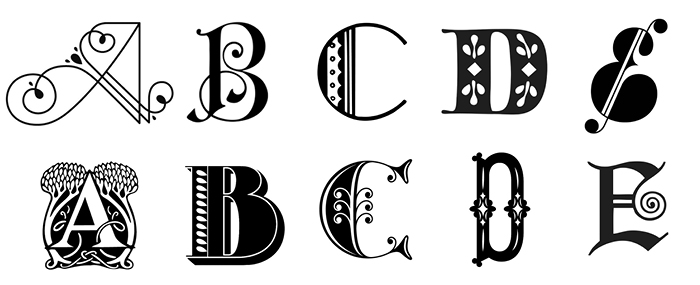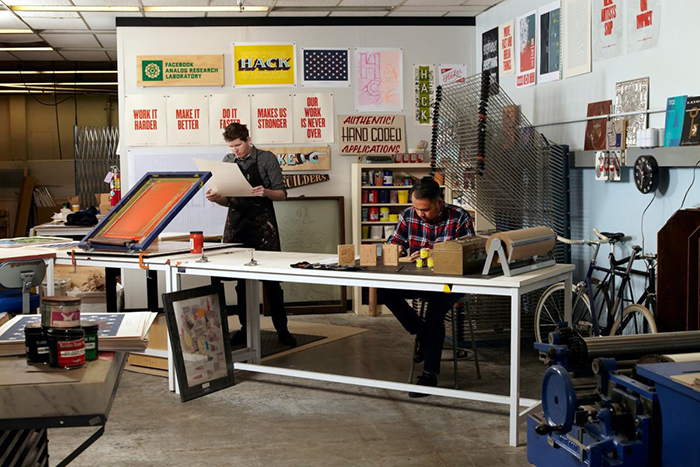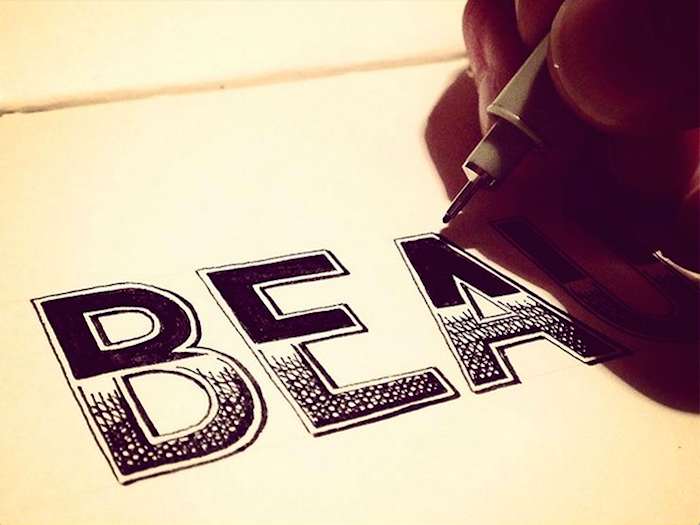This is the second installment in a three-part series based on a lecture Rachel Berger presented to the Pinterest design team in August 2015 on current trends in graphic design.
While the Bay Area is the epicenter of mainstream digital design’s mindless minimalism, it is also at the heart of a decorative zeitgeist. Hipster coffee and barber shops that cater to tech workers and the creative class have embraced a steampunk aesthetic of leather aprons, elaborate mustaches, and gleaming espresso makers that resemble monotype machines. In print design, the NOW’s decorative zeitgeist is inspired by a pre-digital— even pre-modern—age of letterpress, screen printing, hand-lettering, sign painting, and mural making. The period influence is so strong that it can be hard to tell the difference between true vintage lettering and examples of it from the NOW. Below is a mix of drop caps from lettering artist Jessica Hische’s Daily Drop Cap project and from the Briar Press’s collection of nineteenth-century cuts. Rollover to see which are Hische’s.

Jessica Hische and Briar Press
The decorative zeitgeist is also deeply connected to the digital zeitgeist.
Many leading tech startups are infatuated with hand craftsmanship and “low technology.” A couple years ago, Twitter relocated two nineteenth-century cabins from rural Montana to its San Francisco headquarters. Facebook’s Analog Research Lab, where designers and artists create printed ephemera using pre-digital means, is an oft-cited example of a tech company’s regard for vintage tools. At its best, the lab feeds the creative culture of the company. However, it sometimes feels like a well funded vanity project—unrelated to the core business, a relatively inexpensive way to keep designers happy, a petting zoo for retrograde technologies (and technologists).
Tech companies guilty of following the herd on digital design hire lettering artists to decorate their workspaces—and feed their souls. Erik Marinovich recently partnered with New Bohemia Signs to create a mural at the headquarters of Tripit, the travel organizing app.

Facebook Analog Research Lab
In the NOW, young lettering artists like Hische and Marinovich are rockstars in the creative community, with tens of thousands of followers on Twitter and Instagram, international speaking gigs, and seemingly endless commissions from the business, culture, and publishing sectors. At California College of the Arts, where I chair the graphic design program, students adore Hische and Marinovich and are more eager to learn hand lettering and calligraphy than coding and scripting. Who can blame them? They are already sick of their computers, and they aren’t even in professional practice yet.
San Francisco-based architect Olle Lundberg has worked with many tech companies, including Twitter. In a 2014 New Yorker article, Lundberg commented on the tech world’s hunger for the real:
We have lost the visual connection to the maker in our lives, and our tech clients are the ones who feel most impoverished by it, because they’re surrounded by the digital world,” he says. “They’re looking for a way to reestablish their individual identity, and we’ve found that introducing real crafts is one way to do that.
In the Bay Area of the NOW, we are all part of the tech world. And so we all hunger for the real.
Pinterest, a digital tool that enables users to save, sort, and browse images, is the megaphone of the decorative zeitgeist. Pinterest users pin and repin endless images of elaborate dropcaps and ampersands, hand-inked inspirational quotes, and letterpress-printed wedding invitations. Often, markers, sketchpads, and other analogue tools are artfully arranged in the frame, providing irrefutable evidence of the making process. On Pinterest, the “hand lettering” category has more than six million followers. Meanwhile, poor “cooking” has fewer than 100,000. In September, the mostly virtual connection between the digital and decorative zeitgeists spilled back into the real world: Pinterest hosted Jessica Hische’s book launch party.

Hand lettering image from Pinterest
Unfortunately, the decorative zeitgeist is not the path to redemption from minimalist digital monotony. After a while, ornamentalism becomes its own sea of sameness. The hundreds (if not thousands) of young designers who are jumping into the hand-lettering game are too reliant on a particular maximalist aesthetic, with elaborate swashes, display capitals, conjoined letterforms, and decorative flourishes, and even the increasingly rigid rituals of documenting and sharing the work (tools en scene, Instagram Valencia filter).
For a designer of the NOW, it can be hard to know how to make great work without falling victim to all these minimalist or maximalist clichés.
In the next installment, I will explore an under-utilized and increasingly visionary source of creative inspiration.


Comments [2]
12.02.15
03:15
12.16.15
02:49